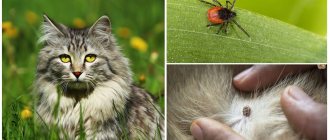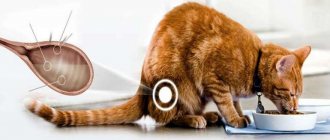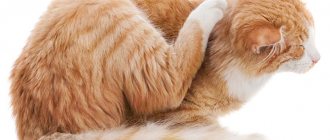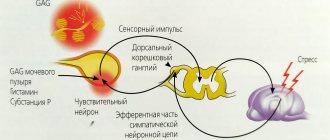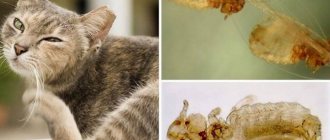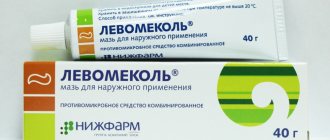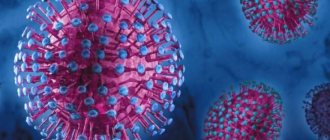Early detection of signs of cat flu in your pet, especially if you have other cats, is important to ensure proper care and treatment.
Cat flu is a common disease that affects the upper respiratory tract of cats. Cat flu is often seen with symptoms affecting very young, very old cats and animals with weak immune systems, including cats with leukemia virus and immunodeficiency virus.
Symptoms
The main signs of cat flu are sneezing, rhinitis and conjunctivitis.
Depending on the pathogen, the following symptoms occur:
- cough;
- profuse drooling;
- ulceration of the oral mucosa or cornea of the eye;
- unpleasant odors from the mouth;
- loss of appetite;
- hyperthermia;
- lameness;
- blindness.
Ulcerative stomatitis
Secondary microflora joins the viral infection, which aggravates the clinical symptoms. A cat with a strong immune system can cope with the disease on its own within a week. A weakened animal recovers after twenty days of timely treatment. Young animals, older individuals, as well as cats suffering from leukemia or viral immunodeficiency usually die.
The most unpleasant complications are chronic rhinitis and panophthalmitis. After recovering from the disease, the animal acquires immunity, but remains a reservoir of infection for a long time.
Panophthalmitis
Diagnostics
Diagnosis should not take place at home - the diagnosis can only be made by a professional in a veterinary clinic. No matter how obvious the signs of the disease may be to you, you will not be able to find out on your own what virus caused this condition.
An experienced doctor can most often make a diagnosis without tests, but only they can tell 100% about the cause. Usually the virus is detected after a thorough examination, less often - based on research at the molecular level.
Treatment
Regardless of the cause of influenza, the therapeutic strategy is developing in the following areas:
- Ensuring optimal conditions of detention.
- Organization of balanced nutrition.
- Destruction of the pathogen.
- Symptomatic therapy.
Ensuring zoohygienic parameters
Drug treatment does not have the desired effect if the animal is kept in unsanitary conditions. Nurseries are equipped with separate rooms where sick individuals are sent.
Balanced diet
Adequate feeding is necessary for the production of antibodies that protect the body from the penetration of infectious agents. Sick animals develop stomatitis, so they need soft, moist food. The optimal solution is premium canned food.
Medicinal food
Destruction of the pathogen
Active immunization and antimicrobial agents are used.
In the first days of the disease, Vitafel globulin is indicated, containing antibodies against calcivirus, herpes and parvovirus.
Vitafel
The following nonspecific agents are effective in stimulating the production of proteins that protect the body from the introduction of pathogens of infectious diseases, as well as immunocompetent cells:
- Immunofan;
- Cycloferon;
- Phosphprenyl;
- Katozal;
- Maxidin;
- Ribotan.
The greatest harm is caused not by viruses, but by secondary microflora. Therefore, antimicrobial agents, mainly cephalosporins, are in demand.
Symptomatic therapy
The following groups of drugs are used to treat symptoms of influenza:
- For rhinitis, dual-purpose drops Anandin or Thymogen are effective, which can also be used for instillation into the eyes.
- Detoxification. To remove toxic metabolites and prevent dehydration, drip administration of Reopoliglucin, Sorbilact or Ringer-Locke solution is practiced.
- Sanitation of the mouth cavity is carried out with Chlorhexidine or Furacilin.
- To relieve joint pain, use Stop-Arthritis or Ketofen.
- Eye diseases are treated with special drops or ointments.
- To improve well-being, general strengthening agents are used - Gamavit, Multivit, Aminovit.
Treatment of influenza in cats
Treatment of feline influenza is carried out at home.
Treatment of uncomplicated influenza in cats is mainly symptomatic. When a secondary bacterial infection develops, leading to the development of pneumonia, the veterinarian has to resort to prescribing antibiotics, including modern ones - cephalosporins. In case of severe nasal congestion, pet owners use inhalations, which dilute nasal exudate and make breathing easier.
As an antiviral drug, veterinary specialists prescribe maxidin and fosprinil to a sick cat.
Since influenza causes cats to smell poorly, it is recommended that they use soft, highly flavored food (fish in oil, kitten food) to increase their appetite. Food for a sick cat is given warmed. Sometimes, in severe cases of the disease, veterinary specialists have to resort to hospitalization of the animal and feed it through a tube. In order to combat dehydration, one has to resort to parenteral or intravenous administration of electrolyte solutions (Ringer's solution, saline with 5% glucose solution, etc.).
As maintenance therapy, the use of interferon (high doses of recombinant human or feline interferon), Gamavit, Baksin is recommended. Additionally, drops and ointments are used as therapeutic drugs for influenza in cats, which can be used to treat conjunctivitis caused by herpervirus (cidofovir, idoxuridine and trifluridine). Famiciclovir has recently been used for oral administration.
When a cat is sick, caring for the sick animal is of great importance. The owner should periodically carefully remove discharge from the eyes and nose with a damp swab. During treatment, the cat should live in a warm and comfortable place.
Prevention
In addition to bringing housing and feeding parameters to the recommended standards, preventive measures include regularly performing the following procedures:
- vaccination;
- deworming;
- disinfestation;
- disinfection.
Cat flu affects animals with weakened immune systems. Predisposing factors are crowded housing, unsanitary conditions, unbalanced nutrition, infestation, ectoparasites, non-compliance with the vaccination plan. To protect pets from the flu, it is necessary to eliminate the listed shortcomings.
We invite you to join our Zen channel and group on VKontakte or Odnoklassniki, where new articles for pet owners are published.
Similar articles:
- If your cat has food allergies
- Ringworm Caution: What Pet Owners Need to Know
- Why are cats overweight?
How to treat cat flu
If your cat has been diagnosed with cat flu, then your veterinarian will prescribe symptomatic treatment. Good care is also important:
- Keep your cat in a quiet, warm place with access to food, water and a litter box.
- Keep any stress levels to a minimum; Isolate your cat from other pets and noisy children.
- Remove nasal or eye discharge with a damp piece of cotton wool. You can relieve nasal congestion by placing your cat in a steamy bath or near a bowl of hot water. It is important to keep an eye on your pet.
- Cat flu is similar to human flu when it comes to a limited sense of smell. You can encourage your cat to eat by heating food or offering her a wide variety of flavored foods. The veterinarian may also prescribe a syringe-fed diet. Finally, provide your animal with plenty of fresh drinking water.
- Your veterinarian may prescribe antibiotics. This medicine makes breathing easier and reduces pain. The doctor also prescribes eye ointment. Sometimes it may be necessary to place the cat in the veterinary practice's isolation ward. Isolation is used to avoid transmitting the virus to other cats.
If a complication requires hospitalization, then intravenous fluids for hydration and medications to stimulate appetite may be required. If you have multiple cats, it is recommended to isolate the infected cat from uninfected cats. Remember that the infected animal should be provided with separate food/water bowls and a litter box - these should be disinfected with a suitable disinfectant. Uninfected cats should be handled using separate clothing/shoes and disposable aprons and gloves to avoid spreading the disease.
How to prevent cat flu?
There are many different types of the disease and, as in the human equivalent, the vaccine is not always effective against everything. However, regular vaccinations are the most effective way to reduce the risk of developing cat flu. Kittens gain immunity from their mothers, but as they get older this disappears and they become susceptible to infection. Vaccination is given at the age of nine weeks, then after twelve weeks, and then annually. Flu vaccines are not always guaranteed to prevent illness, but they do prevent more severe illness.
Is the disease dangerous for the animal?
The course of the disease depends on the type of pathogen:
Calicivirus is less dangerous and has a mild form. With early diagnosis and treatment it does not lead to complications. In kittens up to 6 months from birth, this virus can cause pneumonia.- Herpesvirus causes severe pathology. The pathogen can infect not only the lungs, but also the entire body of the pet. Serious complications often develop and death is possible.
It is important to diagnose the disease promptly and correctly . The outcome of treatment depends on this.
Treatment at home
Since the disease is viral in nature, there are no specific drugs that can completely eliminate it. Therapy is aimed at maintaining the cat’s condition, strengthening its immunity, and relieving symptoms of the disease. All therapeutic measures and medications must be prescribed by a veterinarian, taking into account the condition of the cat, its age and the causative agent of the disease.
The treatment regimen includes:
- Antiviral drugs for cats (
, Cycloferon, Forvet, Kamedon, Anandin). - Antibiotics (Cephalosporins, Clamoxil).
- Immunostimulants (Gamavit).
- Steam inhalation for breathing problems.
- Interferon to strengthen the body's resistance.
- Rinsing the nose and eyes with special means.
- Eye ointments and drops for conjunctivitis (cidofovir, trifluridine).
- Painkillers.
- Antipyretics for fever.
- Drink plenty of fluids.
- Dropper for complete refusal of food.
Use medications only as prescribed by your veterinarian.
Caring for a sick cat
An important part of effective treatment is special care for the cat. The first thing to do is to isolate the sick animal from healthy pets.
- Give your pet water to prevent dehydration. If the cat refuses to drink on its own, forcefully inject water into its mouth using a syringe without a needle or syringe.
- Switch your cat to soft liquid food if he refuses to eat dry food.
- Add strong-smelling foods (liver, fish, wet food) to your cat's food to increase your cat's appetite.
- Clean your pet's eyes thoroughly with a cotton swab dipped in boiled water.
- Regularly ventilate and humidify the air in the rooms where the cat is located.
- Carry out wet cleaning of premises with disinfectants daily.
How long does the disease last?
From the appearance of the first clinical symptoms to complete recovery in mild cases of the disease, 5 to 10 days pass. In severe cases, the disease lasts up to 6 weeks. The duration depends on the condition of the animal, its age and the type of pathogen.
If cat flu is caused by a strain of herpes, cats remain infected for the rest of their lives. The first time the infection is most severe, subsequent relapses are more easily tolerated. Repeated cases are caused by decreased immunity and stress.
Influenza caused by the calicivirus FCV is usually more easily tolerated by cats, but it may take several weeks for complete recovery to occur. After treatment, animals can remain carriers of the infection for several months, so they must be kept in quarantine.
Do cats get sick?
Cats, like people, are living beings with peculiarities of body functioning and a certain functioning of the immune system. During their lives, some pets have to deal with various pathologies, diseases, and infections. Statistics show that people get sick much more often. The reason for this is closer contact with the outside world. And now, when you come home, you feel the first signs of a cold. Are you afraid of infecting your cat? Completely in vain.
As numerous studies and experiments show, cats do not catch human colds. Even if you cough and sneeze on your pet, infection will not occur. You can be treated calmly and do not limit contact with the animal. It is important to remember that such confidence should only be present if the unpleasant symptoms are a manifestation of a cold. The situation is different with a disease such as influenza.
What to do if infected and how to identify it?
Can human flu spread to cats? The answer to this question can be either positive or negative. It all depends on the type of infection and the strain of the virus. The common cold and seasonal flu are rather safe for four-legged pets. The situation is more complicated with those types of diseases that can affect both people and animals. No one is immune from such infection. If you are worried about the health of your tailed friend, then be especially attentive to his well-being. At the first symptoms or suspicious behavior of your cat, go to the veterinarian. Pathology manifests itself in animals as follows:
- The cat sneezes and clear liquid comes out of its nose. The heel itself is dry, which indicates an increase in body temperature.
- A cough appears, accompanied by vomiting. The cat refuses to eat, its state is lethargic and apathetic.
- Tears are released profusely from the animal's eyes. They become inflamed and painful, and photophobia occurs.
- Ulcers may appear in the mouth and on the mucous membranes of the eyes.
- The cat is worried about abdominal discomfort. Murka may develop diarrhea.
After you show your sick animal to the doctor, certain examinations will be carried out. Don’t forget to let them know that you yourself are sick too. Tell us about your diagnosis. This will make it easier for the veterinarian to determine the cat’s pathology. Success largely depends on the correct diagnosis.
Causes of infection
The disease can develop if the following viruses enter the animal’s body:
- Calicivirus (Feline calicivirus). Affects the upper respiratory tract. Both domestic and wild individuals can become infected. Can be compared to the human cold.
Herpesvirus (Feline Herpes Virus) or rhinotracheitis. The infection spreads through the respiratory tract throughout the animal's body. In addition to breathing problems, it affects the organs of vision. Often has complications, accompanied by a bacterial infection.- Chlamydia Chlamydophila felis. Acts as a pathogen in cases of weak immunity.
The disease can also occur with the development of concomitant diseases that influence the development of the disease - obesity, leukemia, immunodeficiency.
How the infection spreads
An animal can become infected in two ways:
Upon contact with a carrier of infection. The virus is transmitted by airborne droplets, even if the sick pet has no visible symptoms. During the incubation period, which lasts from 2 to 10 days, the animal is a carrier of the disease.- Infection is indirect. In this way, cats in shelters and foster care are more often infected. This happens because pets eat from the same bowls and have a common bed. Failure to comply with sanitary standards leads to the development of the disease.
The first symptom is runny nose . Having discovered it, the sick animal should be immediately removed from the rest of the pets.
Which cat can get sick?
Cats that have previously suffered from pneumonia are at risk. Their immunity is weakened, and the virus attacks the body faster. May get sick:
- kittens who have not received the vaccine;
cats over 10 years old;- adults not vaccinated against infections;
- pets from shelters walking on the street;
- cats who have suffered serious illnesses or surgeries;
- animals living in private houses.
Vaccination can keep an animal safe, so domestic cats and pets living in shelters should be vaccinated to prevent an outbreak of infection.
Pets can't catch flu from humans - expert
On Friday, information appeared in the media that pets can catch the flu from their owners. However, in an interview with the 360 TV channel, veterinarian Marina Rivera denied this information, saying that animals and people have different viral diseases.
"Complete nonsense. This is impossible. Human flu does not spread to cats, dogs, birds, or anyone else. These are two completely different strains. All viral diseases are different in people and animals,” said the interlocutor of the 360 TV channel.
According to Rivera, among the viral diseases that cats get are flu-like calcivirosis and rhinotracheitis. However, they can be avoided by vaccinating your animal once a year.
How to try not to get the flu
“There is no cat flu, there is calcivirosis, rhinotrachiitis, which can be called flu, but this is not so. These are standard feline viral diseases, and to prevent them, animals must be vaccinated,” Riviera emphasized.
Cynologist, head of the educational laboratory of the Department of Anatomy of the Scriabin Veterinary Academy, Alexander Vlasenko, was very surprised by the information that appeared that animals can become infected with the flu from humans. According to Vlasenko, these data are not true.
“This is the first time I have heard of this disease being common in dogs, cats and humans. [People and animals] have very few common diseases, the most dangerous is rabies, in second place are skin diseases,” the 360 interlocutor said.
Natalya Yufereva, the chief veterinarian of the Fauna clinic, also denied information about the possible transmission of the influenza virus from humans to pets.
“There are diseases that are specific only to animals and that are specific only to humans. And there are anthroponotic diseases that are characteristic of both animals and people. But the flu is not a common disease for us, nor is it for dogs. The possibility of infection is excluded,” Yufereva said.
Earlier, the Russian News Service, citing Anna Mikheeva, a veterinary specialist at the Zoodrug clinic, reported that pets can become infected with seasonal diseases from their owners.
“Animals can get all types of respiratory diseases from people. Owners should be careful, don’t kiss them, don’t lick them, and generally try to have less contact,” Mikheeva said.
According to her, the symptoms in animals are the same as in humans: sore throat, fever, runny nose. Infectious disease virologist Sofia Rusanova noted that not all types of influenza are dangerous for animals.
“Virus A H1N1 is an anthropozoonosis, that is, it can affect both people and animals. Viruses B and C are anthroponoses, which means they are dangerous only for humans. People get sick with all these strains,” the expert said.
It was previously reported that in Russia the peak of the influenza epidemic will occur at the end of January - beginning of February. In a week and a half it will begin to decline. A headquarters to combat influenza was established in every municipality of the Moscow region. Clinics have been transferred to enhanced operating mode. They have the necessary stock of medicines and equipment. Read more>>
